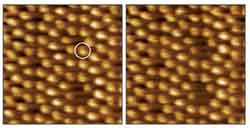How to Grab an Atom

Like a diner spearing a morsel of food with the tine of a fork, researchers have used the tip of a microscopic needle to lift a single atom from a surface and then replace it. The experiment, reported in the 2 May PRL, marks the first time single atoms have been manipulated using a purely mechanical technique, rather than one involving electric current. The new method could allow researchers to maneuver single atoms of nonconductive as well as conductive materials, perhaps for nanoscale circuits of the future.
To image the atomic-scale topography of a surface with a scanning tunneling microscope (STM), you apply a voltage to a microscopic needle, move it slowly across the surface, and continually measure the electric current that flows between tip and surface. A similar device called an atomic force microscope (AFM) images a surface by measuring mechanical forces on the tip, so it works for nonconducting materials as well. In 1989, a team at IBM showed that they could use an STM tip to move atoms, and they spelled out the letters “I-B-M” with 35 individual xenon atoms on a nickel surface. Since then, STM’s have been popular for moving atoms in more complicated patterns, but no one has manipulated atoms on a nonconducting surface.
Now a team of researchers at Osaka University in Japan has performed a feat similar to that of the IBM team, but using an AFM instead of an STM. The researchers lowered a silicon AFM tip toward a silicon surface and pushed down on a single atom. The focused pressure apparently forced the atom free of its bonds to neighboring atoms, which allowed it to bind to the AFM tip. When they lifted the tip and imaged the material, they saw a hole where the atom had been. Finally, they used the tip to press into the vacancy left behind and replace the selected atom–this time using the pressure to break the bond with the tip. Team member Óscar Custance says that in terms of precision, the task is like using the apex of the Empire State Building to lift a single watermelon out of a watermelon field.
Ruben Perez of the University of Madrid is impressed by the team’s work. “It’s the kind of thing that’s easy to imagine,” he says, “but it’s not easy to do, because you have to do it in a very gentle and very controlled way.” Custance says nonconducting materials are essential parts of today’s electronic circuits, so researchers will need to manipulate such atoms to make nanocircuits in the future. But he concedes that atomic-scale circuits are still “science fiction.” Perez says experiments like this give experts a better understanding of how to manipulate single atoms as they work toward the goal of atomic-scale devices.
–Lea Winerman
Lea Winerman is a freelance science writer.


